Comprehensive Financial Analysis: Ratios and Business Performance
VerifiedAdded on 2023/06/10
|12
|2900
|66
Report
AI Summary
This report delves into the significance of financial management and its pivotal role in achieving an organization's objectives. It emphasizes the importance of financial statement analysis, specifically focusing on profitability, efficiency, and liquidity through the lens of financial ratios derived from provided income statements. Calculations within the appendix support the analysis, which assesses a company's performance based on sales growth and profit margins. Liquidity is evaluated using current and quick ratios, while business effectiveness is gauged via asset and stock turnover. The report concludes by suggesting strategies to enhance business performance, such as optimizing the gap between accounts receivable and payable, and accelerating stock turnover. Desklib offers a platform to explore similar assignments and study resources.

top17492 3005
Paraphrase This Document
Need a fresh take? Get an instant paraphrase of this document with our AI Paraphraser
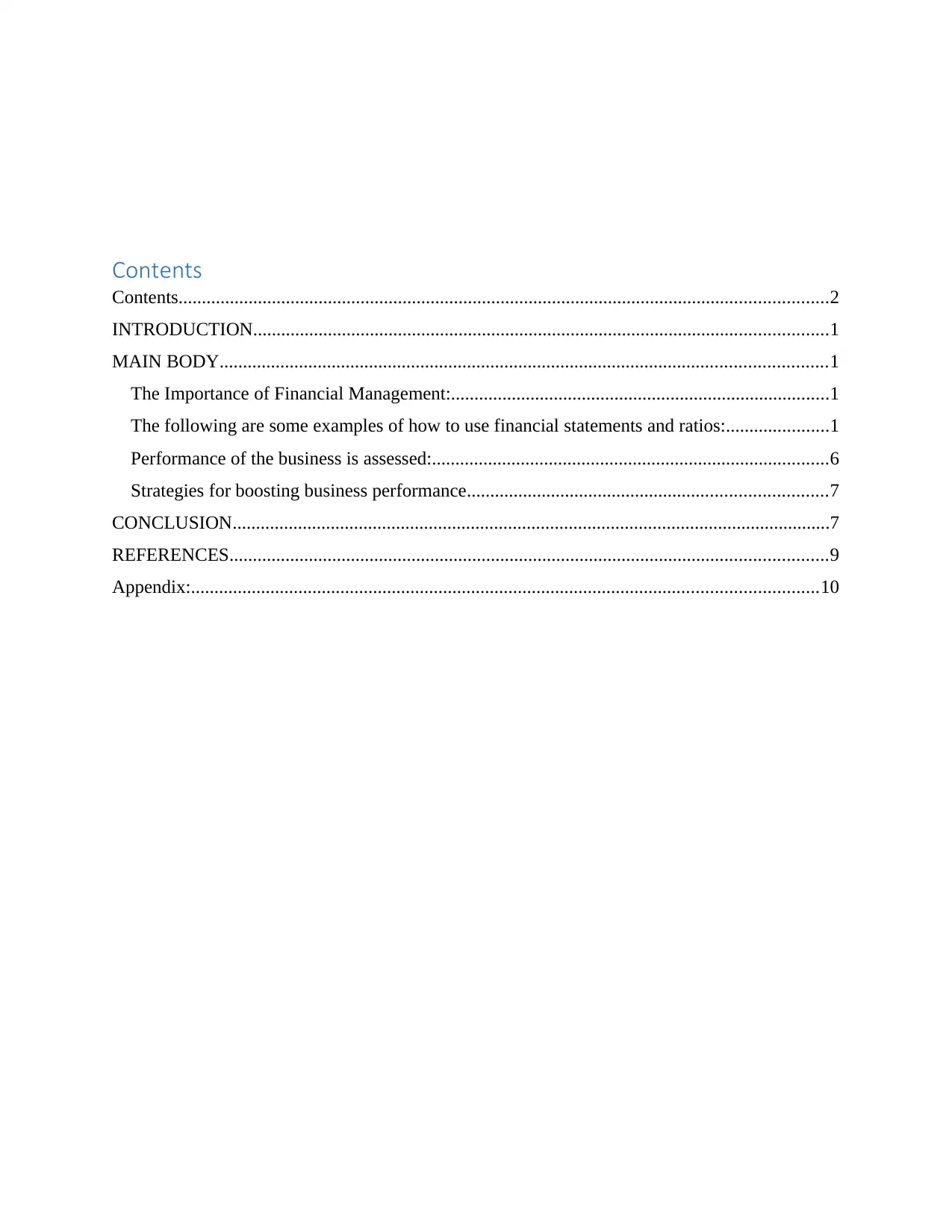
Contents
Contents...........................................................................................................................................2
INTRODUCTION...........................................................................................................................1
MAIN BODY..................................................................................................................................1
The Importance of Financial Management:.................................................................................1
The following are some examples of how to use financial statements and ratios:......................1
Performance of the business is assessed:.....................................................................................6
Strategies for boosting business performance.............................................................................7
CONCLUSION................................................................................................................................7
REFERENCES................................................................................................................................9
Appendix:......................................................................................................................................10
Contents...........................................................................................................................................2
INTRODUCTION...........................................................................................................................1
MAIN BODY..................................................................................................................................1
The Importance of Financial Management:.................................................................................1
The following are some examples of how to use financial statements and ratios:......................1
Performance of the business is assessed:.....................................................................................6
Strategies for boosting business performance.............................................................................7
CONCLUSION................................................................................................................................7
REFERENCES................................................................................................................................9
Appendix:......................................................................................................................................10
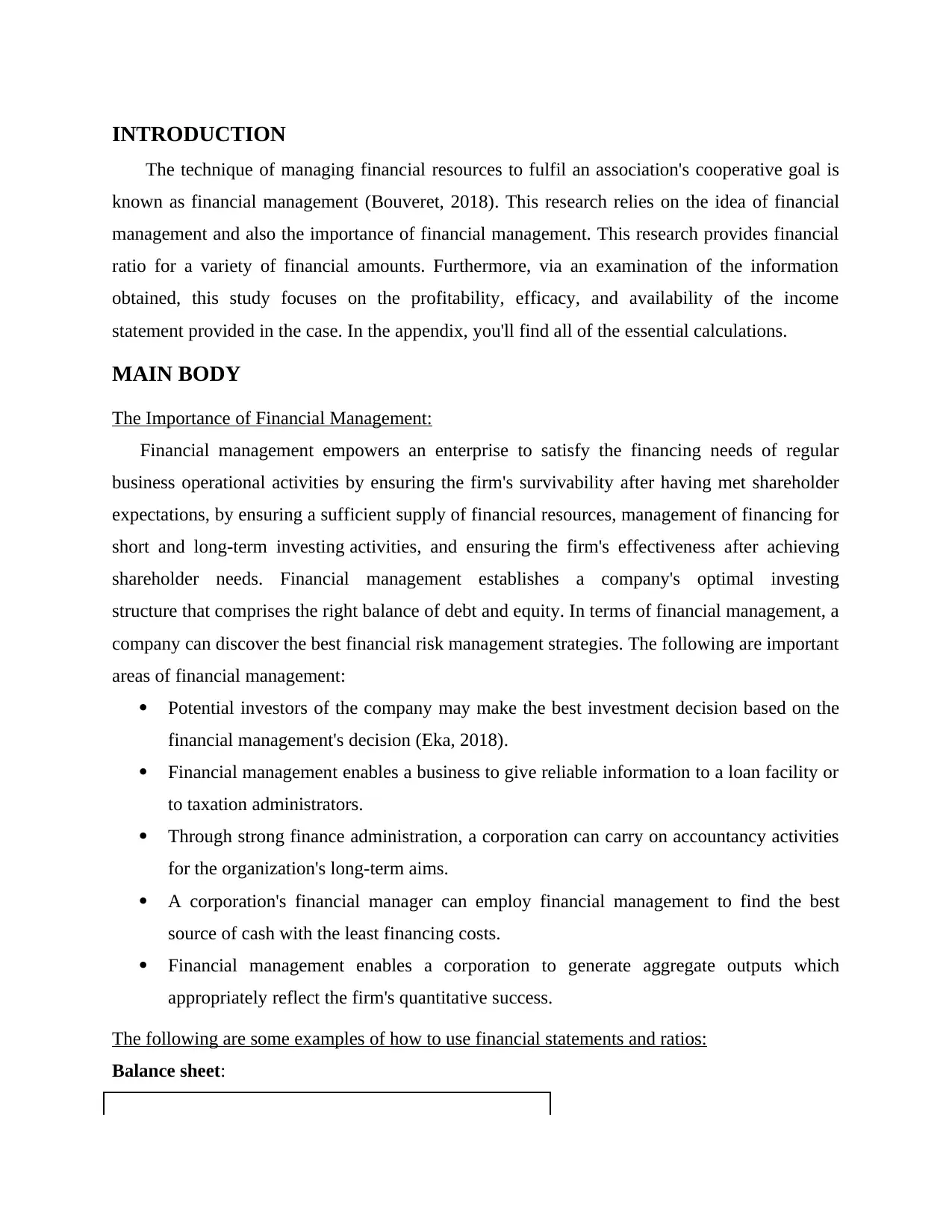
INTRODUCTION
The technique of managing financial resources to fulfil an association's cooperative goal is
known as financial management (Bouveret, 2018). This research relies on the idea of financial
management and also the importance of financial management. This research provides financial
ratio for a variety of financial amounts. Furthermore, via an examination of the information
obtained, this study focuses on the profitability, efficacy, and availability of the income
statement provided in the case. In the appendix, you'll find all of the essential calculations.
MAIN BODY
The Importance of Financial Management:
Financial management empowers an enterprise to satisfy the financing needs of regular
business operational activities by ensuring the firm's survivability after having met shareholder
expectations, by ensuring a sufficient supply of financial resources, management of financing for
short and long-term investing activities, and ensuring the firm's effectiveness after achieving
shareholder needs. Financial management establishes a company's optimal investing
structure that comprises the right balance of debt and equity. In terms of financial management, a
company can discover the best financial risk management strategies. The following are important
areas of financial management:
Potential investors of the company may make the best investment decision based on the
financial management's decision (Eka, 2018).
Financial management enables a business to give reliable information to a loan facility or
to taxation administrators.
Through strong finance administration, a corporation can carry on accountancy activities
for the organization's long-term aims.
A corporation's financial manager can employ financial management to find the best
source of cash with the least financing costs.
Financial management enables a corporation to generate aggregate outputs which
appropriately reflect the firm's quantitative success.
The following are some examples of how to use financial statements and ratios:
Balance sheet:
The technique of managing financial resources to fulfil an association's cooperative goal is
known as financial management (Bouveret, 2018). This research relies on the idea of financial
management and also the importance of financial management. This research provides financial
ratio for a variety of financial amounts. Furthermore, via an examination of the information
obtained, this study focuses on the profitability, efficacy, and availability of the income
statement provided in the case. In the appendix, you'll find all of the essential calculations.
MAIN BODY
The Importance of Financial Management:
Financial management empowers an enterprise to satisfy the financing needs of regular
business operational activities by ensuring the firm's survivability after having met shareholder
expectations, by ensuring a sufficient supply of financial resources, management of financing for
short and long-term investing activities, and ensuring the firm's effectiveness after achieving
shareholder needs. Financial management establishes a company's optimal investing
structure that comprises the right balance of debt and equity. In terms of financial management, a
company can discover the best financial risk management strategies. The following are important
areas of financial management:
Potential investors of the company may make the best investment decision based on the
financial management's decision (Eka, 2018).
Financial management enables a business to give reliable information to a loan facility or
to taxation administrators.
Through strong finance administration, a corporation can carry on accountancy activities
for the organization's long-term aims.
A corporation's financial manager can employ financial management to find the best
source of cash with the least financing costs.
Financial management enables a corporation to generate aggregate outputs which
appropriately reflect the firm's quantitative success.
The following are some examples of how to use financial statements and ratios:
Balance sheet:
⊘ This is a preview!⊘
Do you want full access?
Subscribe today to unlock all pages.

Trusted by 1+ million students worldwide

2016
Total
£0
Non Current assets
Intangible assets 5,793
Tangible assets 52,812
Investments 10,693
69,298
Current assets
Stocks 28,571
Trade debtors 26,367
Short term deposits 14,779
Cash at bank and in
hand 14,632
84,349
Current liabilities
Bank loans and
overdrafts 9,610
Trade creditors 19,493
Other Creditors 678
Income tax payable 3,585
Other creditors
including tax and social
security
4,562
37,928
working capital 46,421
Total assets less
current liabilities 1,15,719
Non Current
Liabilities
Bank loans and
overdrafts 16,506
Other Liabilities 7,304
23,810
Provisions for
liabilities 8,094
Net assets 83,815
Capital and reserves
Called up share capital 39,436
Total
£0
Non Current assets
Intangible assets 5,793
Tangible assets 52,812
Investments 10,693
69,298
Current assets
Stocks 28,571
Trade debtors 26,367
Short term deposits 14,779
Cash at bank and in
hand 14,632
84,349
Current liabilities
Bank loans and
overdrafts 9,610
Trade creditors 19,493
Other Creditors 678
Income tax payable 3,585
Other creditors
including tax and social
security
4,562
37,928
working capital 46,421
Total assets less
current liabilities 1,15,719
Non Current
Liabilities
Bank loans and
overdrafts 16,506
Other Liabilities 7,304
23,810
Provisions for
liabilities 8,094
Net assets 83,815
Capital and reserves
Called up share capital 39,436
Paraphrase This Document
Need a fresh take? Get an instant paraphrase of this document with our AI Paraphraser
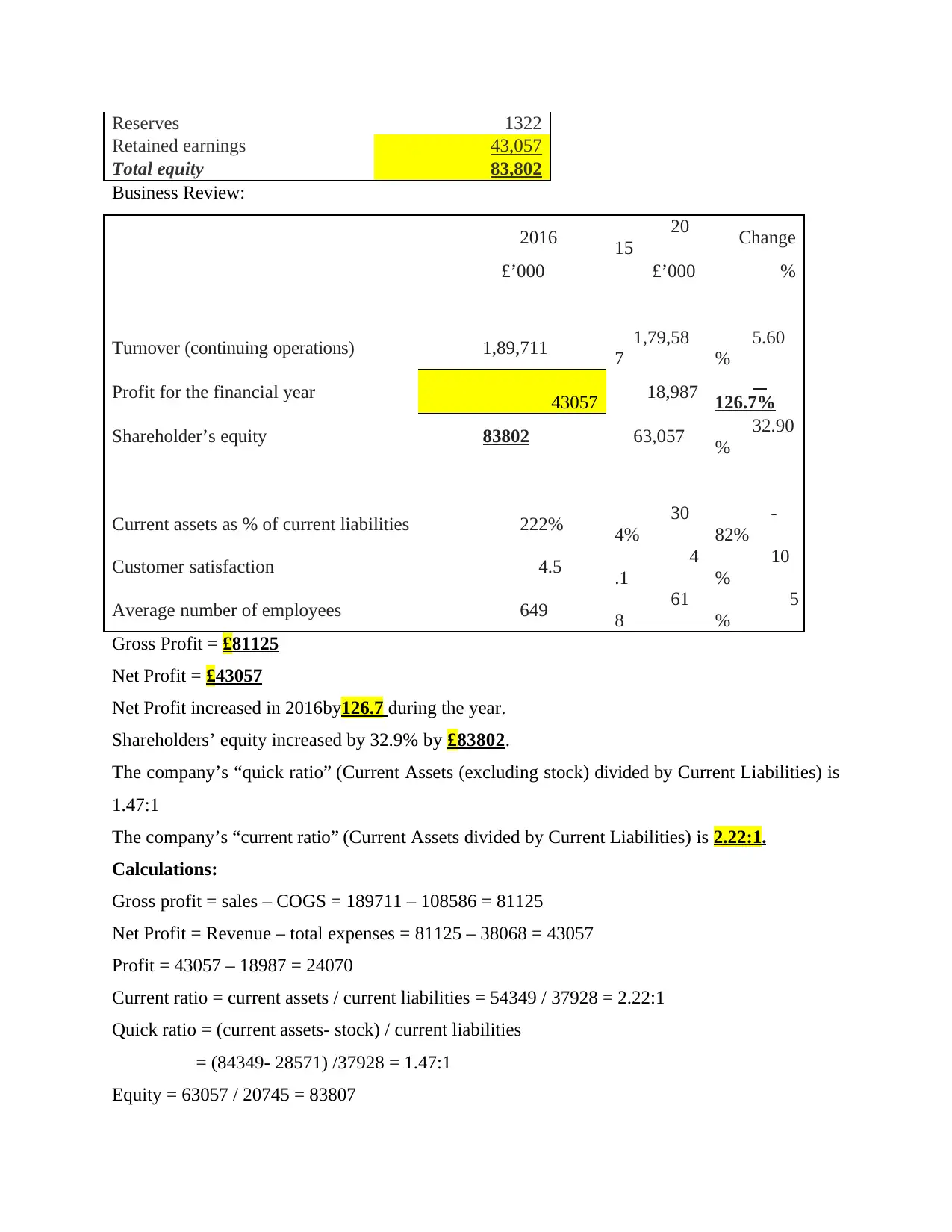
Reserves 1322
Retained earnings 43,057
Total equity 83,802
Business Review:
2016 20
15 Change
£’000 £’000 %
Turnover (continuing operations) 1,89,711 1,79,58
7
5.60
%
Profit for the financial year 43057 18,987 126.7%
Shareholder’s equity 83802 63,057 32.90
%
Current assets as % of current liabilities 222% 30
4%
-
82%
Customer satisfaction 4.5 4
.1
10
%
Average number of employees 649 61
8
5
%
Gross Profit = £81125
Net Profit = £43057
Net Profit increased in 2016by126.7 during the year.
Shareholders’ equity increased by 32.9% by £83802.
The company’s “quick ratio” (Current Assets (excluding stock) divided by Current Liabilities) is
1.47:1
The company’s “current ratio” (Current Assets divided by Current Liabilities) is 2.22:1.
Calculations:
Gross profit = sales – COGS = 189711 – 108586 = 81125
Net Profit = Revenue – total expenses = 81125 – 38068 = 43057
Profit = 43057 – 18987 = 24070
Current ratio = current assets / current liabilities = 54349 / 37928 = 2.22:1
Quick ratio = (current assets- stock) / current liabilities
= (84349- 28571) /37928 = 1.47:1
Equity = 63057 / 20745 = 83807
Retained earnings 43,057
Total equity 83,802
Business Review:
2016 20
15 Change
£’000 £’000 %
Turnover (continuing operations) 1,89,711 1,79,58
7
5.60
%
Profit for the financial year 43057 18,987 126.7%
Shareholder’s equity 83802 63,057 32.90
%
Current assets as % of current liabilities 222% 30
4%
-
82%
Customer satisfaction 4.5 4
.1
10
%
Average number of employees 649 61
8
5
%
Gross Profit = £81125
Net Profit = £43057
Net Profit increased in 2016by126.7 during the year.
Shareholders’ equity increased by 32.9% by £83802.
The company’s “quick ratio” (Current Assets (excluding stock) divided by Current Liabilities) is
1.47:1
The company’s “current ratio” (Current Assets divided by Current Liabilities) is 2.22:1.
Calculations:
Gross profit = sales – COGS = 189711 – 108586 = 81125
Net Profit = Revenue – total expenses = 81125 – 38068 = 43057
Profit = 43057 – 18987 = 24070
Current ratio = current assets / current liabilities = 54349 / 37928 = 2.22:1
Quick ratio = (current assets- stock) / current liabilities
= (84349- 28571) /37928 = 1.47:1
Equity = 63057 / 20745 = 83807
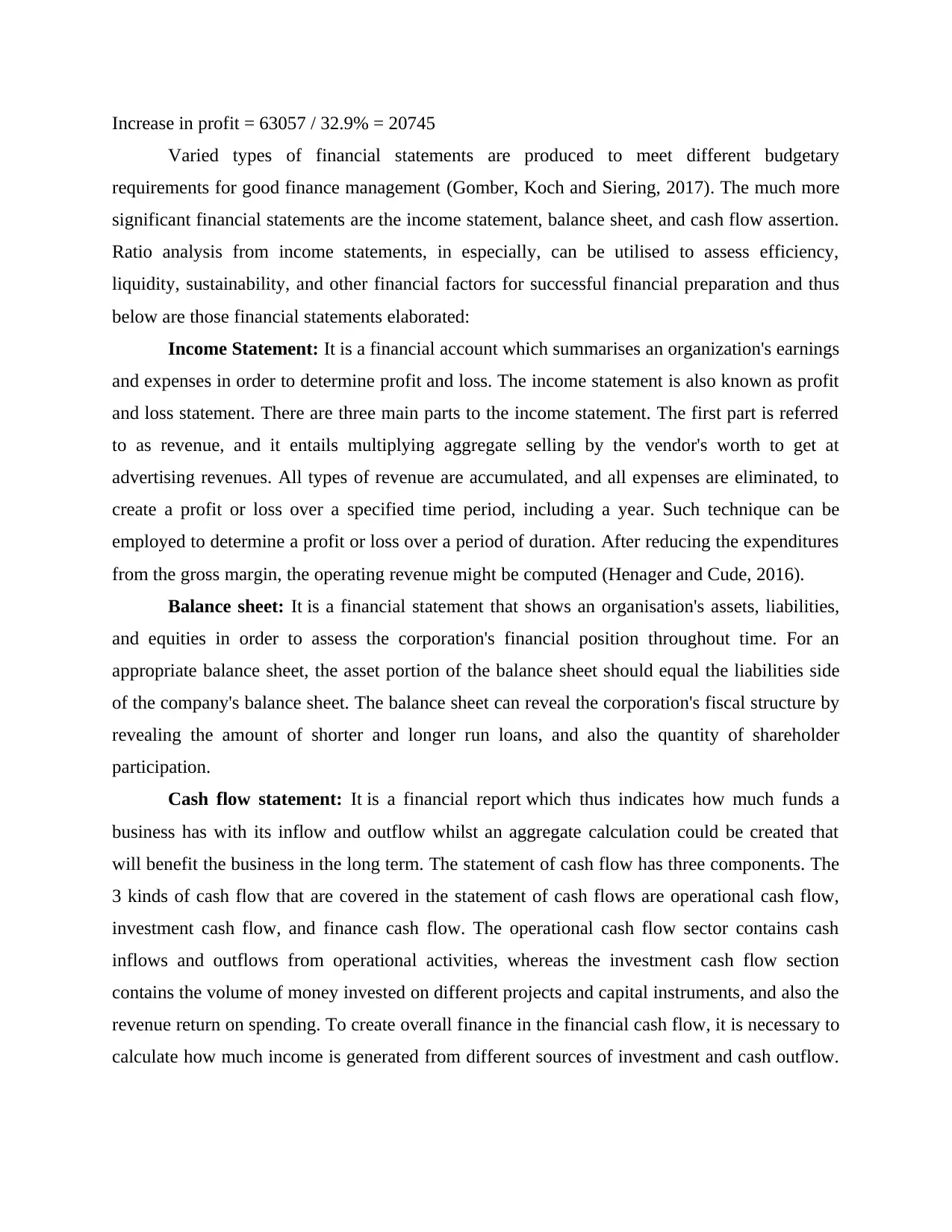
Increase in profit = 63057 / 32.9% = 20745
Varied types of financial statements are produced to meet different budgetary
requirements for good finance management (Gomber, Koch and Siering, 2017). The much more
significant financial statements are the income statement, balance sheet, and cash flow assertion.
Ratio analysis from income statements, in especially, can be utilised to assess efficiency,
liquidity, sustainability, and other financial factors for successful financial preparation and thus
below are those financial statements elaborated:
Income Statement: It is a financial account which summarises an organization's earnings
and expenses in order to determine profit and loss. The income statement is also known as profit
and loss statement. There are three main parts to the income statement. The first part is referred
to as revenue, and it entails multiplying aggregate selling by the vendor's worth to get at
advertising revenues. All types of revenue are accumulated, and all expenses are eliminated, to
create a profit or loss over a specified time period, including a year. Such technique can be
employed to determine a profit or loss over a period of duration. After reducing the expenditures
from the gross margin, the operating revenue might be computed (Henager and Cude, 2016).
Balance sheet: It is a financial statement that shows an organisation's assets, liabilities,
and equities in order to assess the corporation's financial position throughout time. For an
appropriate balance sheet, the asset portion of the balance sheet should equal the liabilities side
of the company's balance sheet. The balance sheet can reveal the corporation's fiscal structure by
revealing the amount of shorter and longer run loans, and also the quantity of shareholder
participation.
Cash flow statement: It is a financial report which thus indicates how much funds a
business has with its inflow and outflow whilst an aggregate calculation could be created that
will benefit the business in the long term. The statement of cash flow has three components. The
3 kinds of cash flow that are covered in the statement of cash flows are operational cash flow,
investment cash flow, and finance cash flow. The operational cash flow sector contains cash
inflows and outflows from operational activities, whereas the investment cash flow section
contains the volume of money invested on different projects and capital instruments, and also the
revenue return on spending. To create overall finance in the financial cash flow, it is necessary to
calculate how much income is generated from different sources of investment and cash outflow.
Varied types of financial statements are produced to meet different budgetary
requirements for good finance management (Gomber, Koch and Siering, 2017). The much more
significant financial statements are the income statement, balance sheet, and cash flow assertion.
Ratio analysis from income statements, in especially, can be utilised to assess efficiency,
liquidity, sustainability, and other financial factors for successful financial preparation and thus
below are those financial statements elaborated:
Income Statement: It is a financial account which summarises an organization's earnings
and expenses in order to determine profit and loss. The income statement is also known as profit
and loss statement. There are three main parts to the income statement. The first part is referred
to as revenue, and it entails multiplying aggregate selling by the vendor's worth to get at
advertising revenues. All types of revenue are accumulated, and all expenses are eliminated, to
create a profit or loss over a specified time period, including a year. Such technique can be
employed to determine a profit or loss over a period of duration. After reducing the expenditures
from the gross margin, the operating revenue might be computed (Henager and Cude, 2016).
Balance sheet: It is a financial statement that shows an organisation's assets, liabilities,
and equities in order to assess the corporation's financial position throughout time. For an
appropriate balance sheet, the asset portion of the balance sheet should equal the liabilities side
of the company's balance sheet. The balance sheet can reveal the corporation's fiscal structure by
revealing the amount of shorter and longer run loans, and also the quantity of shareholder
participation.
Cash flow statement: It is a financial report which thus indicates how much funds a
business has with its inflow and outflow whilst an aggregate calculation could be created that
will benefit the business in the long term. The statement of cash flow has three components. The
3 kinds of cash flow that are covered in the statement of cash flows are operational cash flow,
investment cash flow, and finance cash flow. The operational cash flow sector contains cash
inflows and outflows from operational activities, whereas the investment cash flow section
contains the volume of money invested on different projects and capital instruments, and also the
revenue return on spending. To create overall finance in the financial cash flow, it is necessary to
calculate how much income is generated from different sources of investment and cash outflow.
⊘ This is a preview!⊘
Do you want full access?
Subscribe today to unlock all pages.

Trusted by 1+ million students worldwide
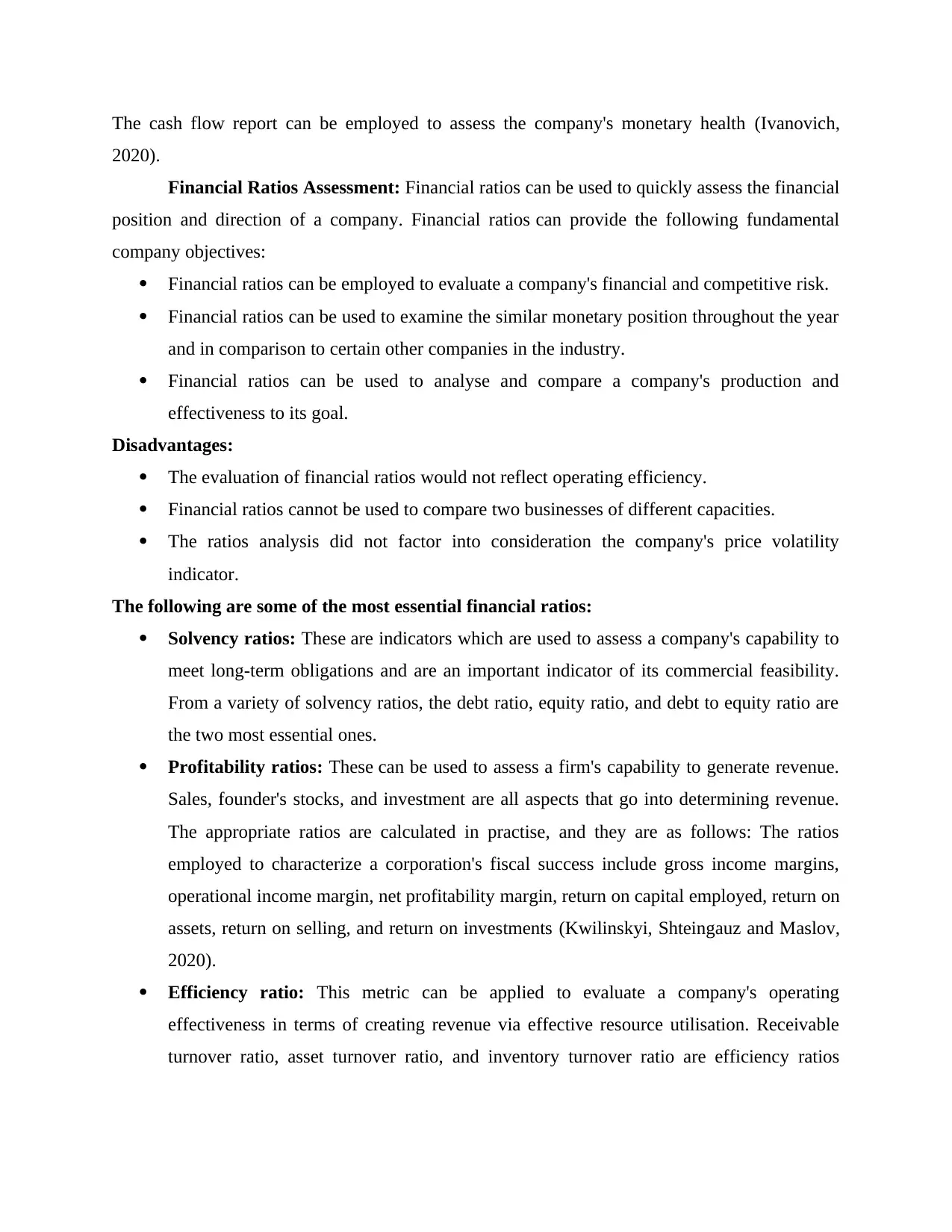
The cash flow report can be employed to assess the company's monetary health (Ivanovich,
2020).
Financial Ratios Assessment: Financial ratios can be used to quickly assess the financial
position and direction of a company. Financial ratios can provide the following fundamental
company objectives:
Financial ratios can be employed to evaluate a company's financial and competitive risk.
Financial ratios can be used to examine the similar monetary position throughout the year
and in comparison to certain other companies in the industry.
Financial ratios can be used to analyse and compare a company's production and
effectiveness to its goal.
Disadvantages:
The evaluation of financial ratios would not reflect operating efficiency.
Financial ratios cannot be used to compare two businesses of different capacities.
The ratios analysis did not factor into consideration the company's price volatility
indicator.
The following are some of the most essential financial ratios:
Solvency ratios: These are indicators which are used to assess a company's capability to
meet long-term obligations and are an important indicator of its commercial feasibility.
From a variety of solvency ratios, the debt ratio, equity ratio, and debt to equity ratio are
the two most essential ones.
Profitability ratios: These can be used to assess a firm's capability to generate revenue.
Sales, founder's stocks, and investment are all aspects that go into determining revenue.
The appropriate ratios are calculated in practise, and they are as follows: The ratios
employed to characterize a corporation's fiscal success include gross income margins,
operational income margin, net profitability margin, return on capital employed, return on
assets, return on selling, and return on investments (Kwilinskyi, Shteingauz and Maslov,
2020).
Efficiency ratio: This metric can be applied to evaluate a company's operating
effectiveness in terms of creating revenue via effective resource utilisation. Receivable
turnover ratio, asset turnover ratio, and inventory turnover ratio are efficiency ratios
2020).
Financial Ratios Assessment: Financial ratios can be used to quickly assess the financial
position and direction of a company. Financial ratios can provide the following fundamental
company objectives:
Financial ratios can be employed to evaluate a company's financial and competitive risk.
Financial ratios can be used to examine the similar monetary position throughout the year
and in comparison to certain other companies in the industry.
Financial ratios can be used to analyse and compare a company's production and
effectiveness to its goal.
Disadvantages:
The evaluation of financial ratios would not reflect operating efficiency.
Financial ratios cannot be used to compare two businesses of different capacities.
The ratios analysis did not factor into consideration the company's price volatility
indicator.
The following are some of the most essential financial ratios:
Solvency ratios: These are indicators which are used to assess a company's capability to
meet long-term obligations and are an important indicator of its commercial feasibility.
From a variety of solvency ratios, the debt ratio, equity ratio, and debt to equity ratio are
the two most essential ones.
Profitability ratios: These can be used to assess a firm's capability to generate revenue.
Sales, founder's stocks, and investment are all aspects that go into determining revenue.
The appropriate ratios are calculated in practise, and they are as follows: The ratios
employed to characterize a corporation's fiscal success include gross income margins,
operational income margin, net profitability margin, return on capital employed, return on
assets, return on selling, and return on investments (Kwilinskyi, Shteingauz and Maslov,
2020).
Efficiency ratio: This metric can be applied to evaluate a company's operating
effectiveness in terms of creating revenue via effective resource utilisation. Receivable
turnover ratio, asset turnover ratio, and inventory turnover ratio are efficiency ratios
Paraphrase This Document
Need a fresh take? Get an instant paraphrase of this document with our AI Paraphraser
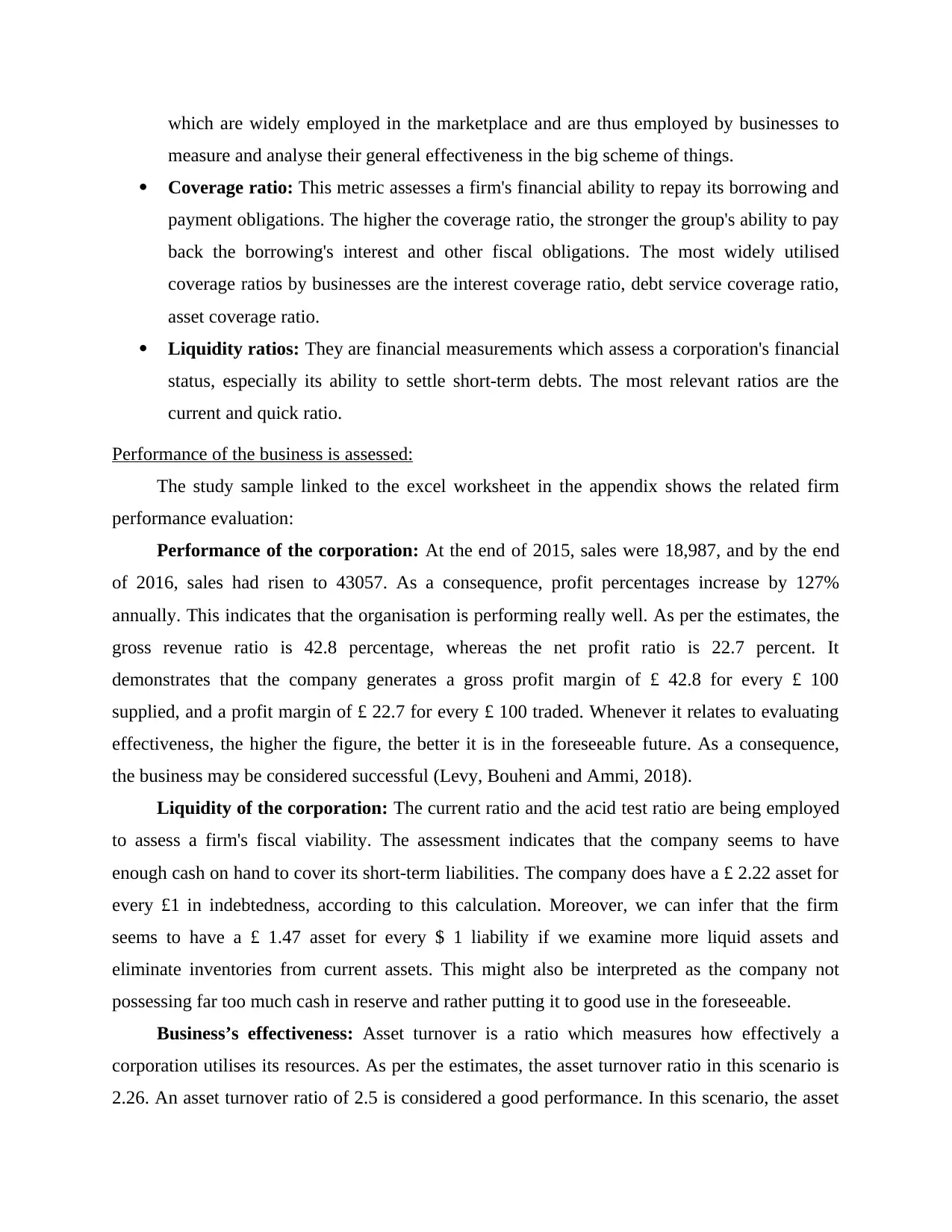
which are widely employed in the marketplace and are thus employed by businesses to
measure and analyse their general effectiveness in the big scheme of things.
Coverage ratio: This metric assesses a firm's financial ability to repay its borrowing and
payment obligations. The higher the coverage ratio, the stronger the group's ability to pay
back the borrowing's interest and other fiscal obligations. The most widely utilised
coverage ratios by businesses are the interest coverage ratio, debt service coverage ratio,
asset coverage ratio.
Liquidity ratios: They are financial measurements which assess a corporation's financial
status, especially its ability to settle short-term debts. The most relevant ratios are the
current and quick ratio.
Performance of the business is assessed:
The study sample linked to the excel worksheet in the appendix shows the related firm
performance evaluation:
Performance of the corporation: At the end of 2015, sales were 18,987, and by the end
of 2016, sales had risen to 43057. As a consequence, profit percentages increase by 127%
annually. This indicates that the organisation is performing really well. As per the estimates, the
gross revenue ratio is 42.8 percentage, whereas the net profit ratio is 22.7 percent. It
demonstrates that the company generates a gross profit margin of £ 42.8 for every £ 100
supplied, and a profit margin of £ 22.7 for every £ 100 traded. Whenever it relates to evaluating
effectiveness, the higher the figure, the better it is in the foreseeable future. As a consequence,
the business may be considered successful (Levy, Bouheni and Ammi, 2018).
Liquidity of the corporation: The current ratio and the acid test ratio are being employed
to assess a firm's fiscal viability. The assessment indicates that the company seems to have
enough cash on hand to cover its short-term liabilities. The company does have a £ 2.22 asset for
every £1 in indebtedness, according to this calculation. Moreover, we can infer that the firm
seems to have a £ 1.47 asset for every $ 1 liability if we examine more liquid assets and
eliminate inventories from current assets. This might also be interpreted as the company not
possessing far too much cash in reserve and rather putting it to good use in the foreseeable.
Business’s effectiveness: Asset turnover is a ratio which measures how effectively a
corporation utilises its resources. As per the estimates, the asset turnover ratio in this scenario is
2.26. An asset turnover ratio of 2.5 is considered a good performance. In this scenario, the asset
measure and analyse their general effectiveness in the big scheme of things.
Coverage ratio: This metric assesses a firm's financial ability to repay its borrowing and
payment obligations. The higher the coverage ratio, the stronger the group's ability to pay
back the borrowing's interest and other fiscal obligations. The most widely utilised
coverage ratios by businesses are the interest coverage ratio, debt service coverage ratio,
asset coverage ratio.
Liquidity ratios: They are financial measurements which assess a corporation's financial
status, especially its ability to settle short-term debts. The most relevant ratios are the
current and quick ratio.
Performance of the business is assessed:
The study sample linked to the excel worksheet in the appendix shows the related firm
performance evaluation:
Performance of the corporation: At the end of 2015, sales were 18,987, and by the end
of 2016, sales had risen to 43057. As a consequence, profit percentages increase by 127%
annually. This indicates that the organisation is performing really well. As per the estimates, the
gross revenue ratio is 42.8 percentage, whereas the net profit ratio is 22.7 percent. It
demonstrates that the company generates a gross profit margin of £ 42.8 for every £ 100
supplied, and a profit margin of £ 22.7 for every £ 100 traded. Whenever it relates to evaluating
effectiveness, the higher the figure, the better it is in the foreseeable future. As a consequence,
the business may be considered successful (Levy, Bouheni and Ammi, 2018).
Liquidity of the corporation: The current ratio and the acid test ratio are being employed
to assess a firm's fiscal viability. The assessment indicates that the company seems to have
enough cash on hand to cover its short-term liabilities. The company does have a £ 2.22 asset for
every £1 in indebtedness, according to this calculation. Moreover, we can infer that the firm
seems to have a £ 1.47 asset for every $ 1 liability if we examine more liquid assets and
eliminate inventories from current assets. This might also be interpreted as the company not
possessing far too much cash in reserve and rather putting it to good use in the foreseeable.
Business’s effectiveness: Asset turnover is a ratio which measures how effectively a
corporation utilises its resources. As per the estimates, the asset turnover ratio in this scenario is
2.26. An asset turnover ratio of 2.5 is considered a good performance. In this scenario, the asset
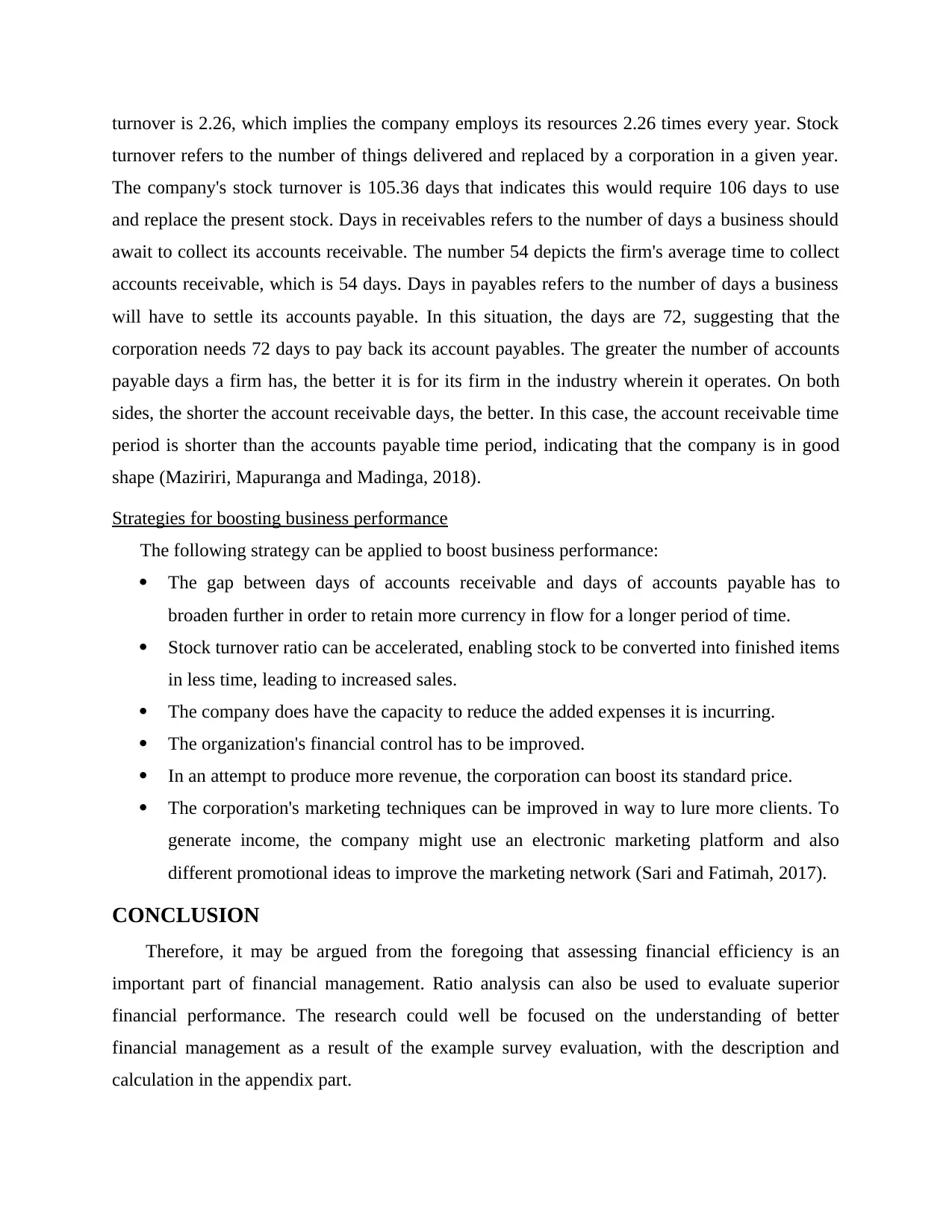
turnover is 2.26, which implies the company employs its resources 2.26 times every year. Stock
turnover refers to the number of things delivered and replaced by a corporation in a given year.
The company's stock turnover is 105.36 days that indicates this would require 106 days to use
and replace the present stock. Days in receivables refers to the number of days a business should
await to collect its accounts receivable. The number 54 depicts the firm's average time to collect
accounts receivable, which is 54 days. Days in payables refers to the number of days a business
will have to settle its accounts payable. In this situation, the days are 72, suggesting that the
corporation needs 72 days to pay back its account payables. The greater the number of accounts
payable days a firm has, the better it is for its firm in the industry wherein it operates. On both
sides, the shorter the account receivable days, the better. In this case, the account receivable time
period is shorter than the accounts payable time period, indicating that the company is in good
shape (Maziriri, Mapuranga and Madinga, 2018).
Strategies for boosting business performance
The following strategy can be applied to boost business performance:
The gap between days of accounts receivable and days of accounts payable has to
broaden further in order to retain more currency in flow for a longer period of time.
Stock turnover ratio can be accelerated, enabling stock to be converted into finished items
in less time, leading to increased sales.
The company does have the capacity to reduce the added expenses it is incurring.
The organization's financial control has to be improved.
In an attempt to produce more revenue, the corporation can boost its standard price.
The corporation's marketing techniques can be improved in way to lure more clients. To
generate income, the company might use an electronic marketing platform and also
different promotional ideas to improve the marketing network (Sari and Fatimah, 2017).
CONCLUSION
Therefore, it may be argued from the foregoing that assessing financial efficiency is an
important part of financial management. Ratio analysis can also be used to evaluate superior
financial performance. The research could well be focused on the understanding of better
financial management as a result of the example survey evaluation, with the description and
calculation in the appendix part.
turnover refers to the number of things delivered and replaced by a corporation in a given year.
The company's stock turnover is 105.36 days that indicates this would require 106 days to use
and replace the present stock. Days in receivables refers to the number of days a business should
await to collect its accounts receivable. The number 54 depicts the firm's average time to collect
accounts receivable, which is 54 days. Days in payables refers to the number of days a business
will have to settle its accounts payable. In this situation, the days are 72, suggesting that the
corporation needs 72 days to pay back its account payables. The greater the number of accounts
payable days a firm has, the better it is for its firm in the industry wherein it operates. On both
sides, the shorter the account receivable days, the better. In this case, the account receivable time
period is shorter than the accounts payable time period, indicating that the company is in good
shape (Maziriri, Mapuranga and Madinga, 2018).
Strategies for boosting business performance
The following strategy can be applied to boost business performance:
The gap between days of accounts receivable and days of accounts payable has to
broaden further in order to retain more currency in flow for a longer period of time.
Stock turnover ratio can be accelerated, enabling stock to be converted into finished items
in less time, leading to increased sales.
The company does have the capacity to reduce the added expenses it is incurring.
The organization's financial control has to be improved.
In an attempt to produce more revenue, the corporation can boost its standard price.
The corporation's marketing techniques can be improved in way to lure more clients. To
generate income, the company might use an electronic marketing platform and also
different promotional ideas to improve the marketing network (Sari and Fatimah, 2017).
CONCLUSION
Therefore, it may be argued from the foregoing that assessing financial efficiency is an
important part of financial management. Ratio analysis can also be used to evaluate superior
financial performance. The research could well be focused on the understanding of better
financial management as a result of the example survey evaluation, with the description and
calculation in the appendix part.
⊘ This is a preview!⊘
Do you want full access?
Subscribe today to unlock all pages.

Trusted by 1+ million students worldwide

Paraphrase This Document
Need a fresh take? Get an instant paraphrase of this document with our AI Paraphraser
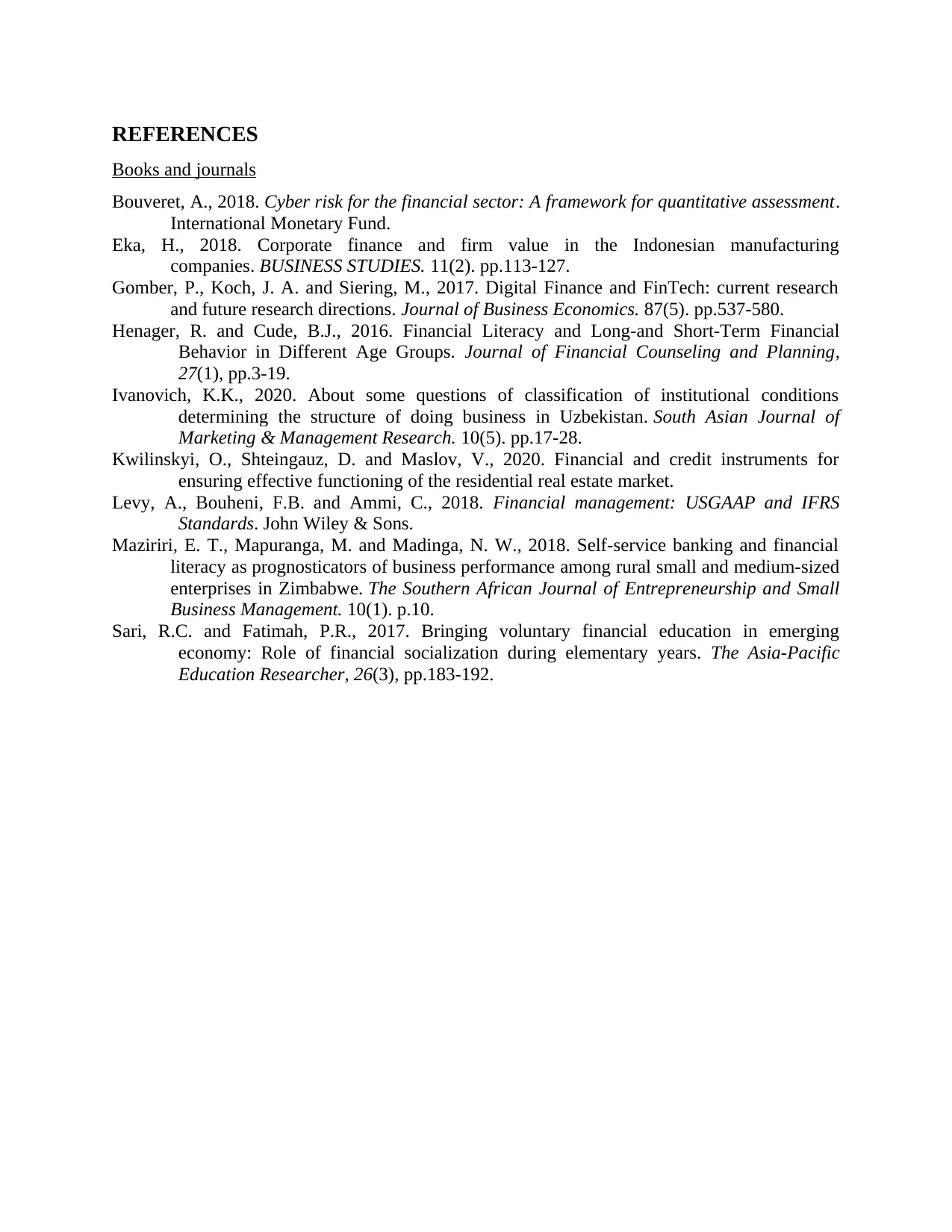
REFERENCES
Books and journals
Bouveret, A., 2018. Cyber risk for the financial sector: A framework for quantitative assessment.
International Monetary Fund.
Eka, H., 2018. Corporate finance and firm value in the Indonesian manufacturing
companies. BUSINESS STUDIES. 11(2). pp.113-127.
Gomber, P., Koch, J. A. and Siering, M., 2017. Digital Finance and FinTech: current research
and future research directions. Journal of Business Economics. 87(5). pp.537-580.
Henager, R. and Cude, B.J., 2016. Financial Literacy and Long-and Short-Term Financial
Behavior in Different Age Groups. Journal of Financial Counseling and Planning,
27(1), pp.3-19.
Ivanovich, K.K., 2020. About some questions of classification of institutional conditions
determining the structure of doing business in Uzbekistan. South Asian Journal of
Marketing & Management Research. 10(5). pp.17-28.
Kwilinskyi, O., Shteingauz, D. and Maslov, V., 2020. Financial and credit instruments for
ensuring effective functioning of the residential real estate market.
Levy, A., Bouheni, F.B. and Ammi, C., 2018. Financial management: USGAAP and IFRS
Standards. John Wiley & Sons.
Maziriri, E. T., Mapuranga, M. and Madinga, N. W., 2018. Self-service banking and financial
literacy as prognosticators of business performance among rural small and medium-sized
enterprises in Zimbabwe. The Southern African Journal of Entrepreneurship and Small
Business Management. 10(1). p.10.
Sari, R.C. and Fatimah, P.R., 2017. Bringing voluntary financial education in emerging
economy: Role of financial socialization during elementary years. The Asia-Pacific
Education Researcher, 26(3), pp.183-192.
Books and journals
Bouveret, A., 2018. Cyber risk for the financial sector: A framework for quantitative assessment.
International Monetary Fund.
Eka, H., 2018. Corporate finance and firm value in the Indonesian manufacturing
companies. BUSINESS STUDIES. 11(2). pp.113-127.
Gomber, P., Koch, J. A. and Siering, M., 2017. Digital Finance and FinTech: current research
and future research directions. Journal of Business Economics. 87(5). pp.537-580.
Henager, R. and Cude, B.J., 2016. Financial Literacy and Long-and Short-Term Financial
Behavior in Different Age Groups. Journal of Financial Counseling and Planning,
27(1), pp.3-19.
Ivanovich, K.K., 2020. About some questions of classification of institutional conditions
determining the structure of doing business in Uzbekistan. South Asian Journal of
Marketing & Management Research. 10(5). pp.17-28.
Kwilinskyi, O., Shteingauz, D. and Maslov, V., 2020. Financial and credit instruments for
ensuring effective functioning of the residential real estate market.
Levy, A., Bouheni, F.B. and Ammi, C., 2018. Financial management: USGAAP and IFRS
Standards. John Wiley & Sons.
Maziriri, E. T., Mapuranga, M. and Madinga, N. W., 2018. Self-service banking and financial
literacy as prognosticators of business performance among rural small and medium-sized
enterprises in Zimbabwe. The Southern African Journal of Entrepreneurship and Small
Business Management. 10(1). p.10.
Sari, R.C. and Fatimah, P.R., 2017. Bringing voluntary financial education in emerging
economy: Role of financial socialization during elementary years. The Asia-Pacific
Education Researcher, 26(3), pp.183-192.
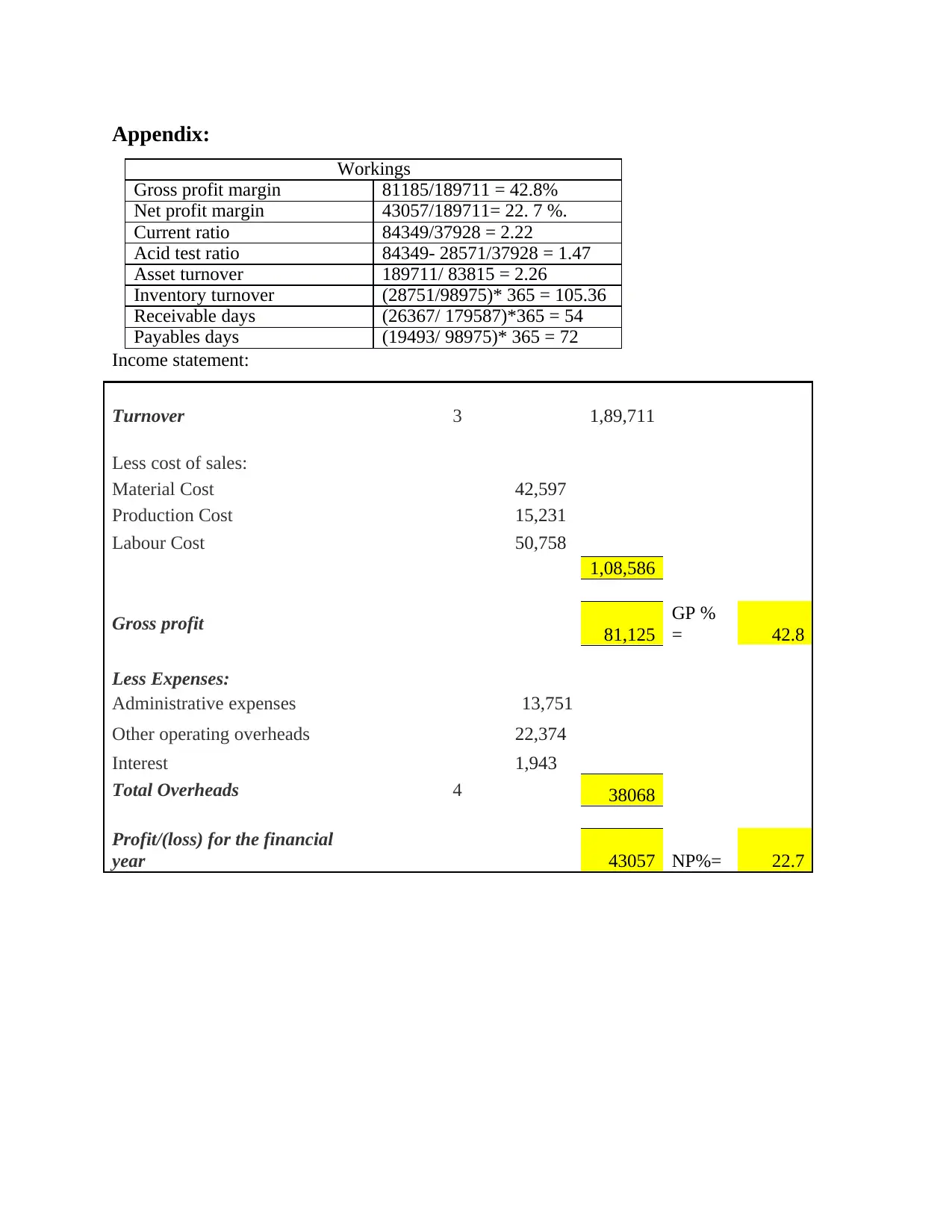
Appendix:
Workings
Gross profit margin 81185/189711 = 42.8%
Net profit margin 43057/189711= 22. 7 %.
Current ratio 84349/37928 = 2.22
Acid test ratio 84349- 28571/37928 = 1.47
Asset turnover 189711/ 83815 = 2.26
Inventory turnover (28751/98975)* 365 = 105.36
Receivable days (26367/ 179587)*365 = 54
Payables days (19493/ 98975)* 365 = 72
Income statement:
Turnover 3 1,89,711
Less cost of sales:
Material Cost 42,597
Production Cost 15,231
Labour Cost 50,758
1,08,586
Gross profit 81,125
GP %
= 42.8
Less Expenses:
Administrative expenses 13,751
Other operating overheads 22,374
Interest 1,943
Total Overheads 4 38068
Profit/(loss) for the financial
year 43057 NP%= 22.7
Workings
Gross profit margin 81185/189711 = 42.8%
Net profit margin 43057/189711= 22. 7 %.
Current ratio 84349/37928 = 2.22
Acid test ratio 84349- 28571/37928 = 1.47
Asset turnover 189711/ 83815 = 2.26
Inventory turnover (28751/98975)* 365 = 105.36
Receivable days (26367/ 179587)*365 = 54
Payables days (19493/ 98975)* 365 = 72
Income statement:
Turnover 3 1,89,711
Less cost of sales:
Material Cost 42,597
Production Cost 15,231
Labour Cost 50,758
1,08,586
Gross profit 81,125
GP %
= 42.8
Less Expenses:
Administrative expenses 13,751
Other operating overheads 22,374
Interest 1,943
Total Overheads 4 38068
Profit/(loss) for the financial
year 43057 NP%= 22.7
⊘ This is a preview!⊘
Do you want full access?
Subscribe today to unlock all pages.

Trusted by 1+ million students worldwide
1 out of 12
Related Documents
Your All-in-One AI-Powered Toolkit for Academic Success.
+13062052269
info@desklib.com
Available 24*7 on WhatsApp / Email
![[object Object]](/_next/static/media/star-bottom.7253800d.svg)
Unlock your academic potential
Copyright © 2020–2026 A2Z Services. All Rights Reserved. Developed and managed by ZUCOL.





